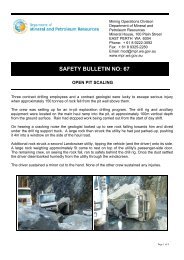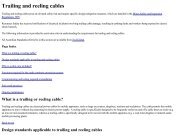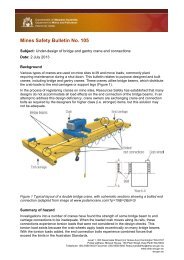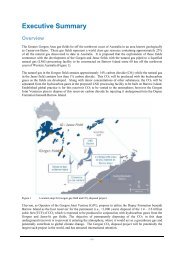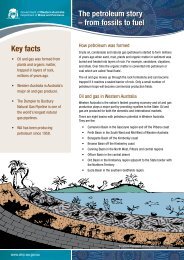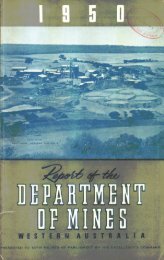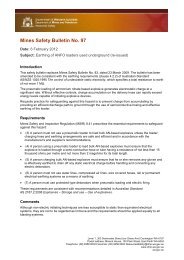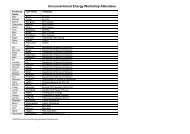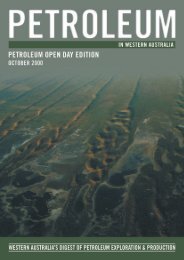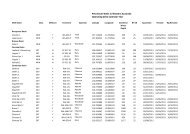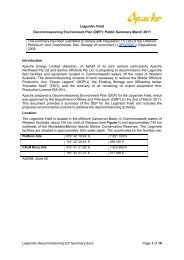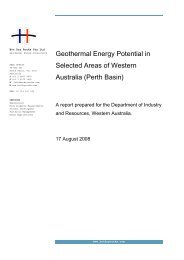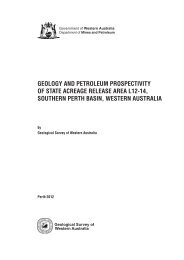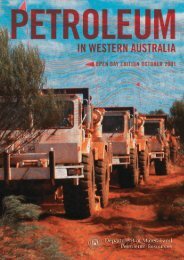IN WESTERN AUSTRALIA - Department of Mines and Petroleum
IN WESTERN AUSTRALIA - Department of Mines and Petroleum
IN WESTERN AUSTRALIA - Department of Mines and Petroleum
Create successful ePaper yourself
Turn your PDF publications into a flip-book with our unique Google optimized e-Paper software.
22<br />
PWA April Edition - Resources Branch Activities<br />
Reza Malek, Manager Resources Branch,<br />
<strong>Petroleum</strong> <strong>and</strong> Royalties Division<br />
The Resources Branch provides a broad spectrum<br />
<strong>of</strong> services to the industry <strong>and</strong> undertakes an<br />
important regulatory role to facilitate the upstream<br />
petroleum industry development. This review hopes<br />
to provide a better underst<strong>and</strong>ing <strong>of</strong> the Resources<br />
Branch roles <strong>and</strong> activities.<br />
There is a significant decision making process<br />
involved in approving field development plans,<br />
production licences, declarations <strong>of</strong> location, wells,<br />
seismic surveys <strong>and</strong> retention leases. The<br />
Resources Branch is effectively the custodian <strong>of</strong> the<br />
natural resources involved in a petroleum field’s<br />
development <strong>and</strong> must ensure that the proposed<br />
development strategy is optimal to maximise<br />
hydrocarbon recovery <strong>and</strong> expedite the project in<br />
the best interests <strong>of</strong> the citizens <strong>of</strong> WA. Thus an<br />
experience-based assessment <strong>of</strong> such proposals is<br />
a prerequisite to a good outcome.<br />
During the past few years the Branch has taken<br />
ambitious <strong>and</strong> creative steps forward <strong>and</strong> has<br />
accomplished a number innovative projects such as<br />
the Atlas <strong>of</strong> <strong>Petroleum</strong> Fields <strong>and</strong> prospectivity<br />
enhancement packages, as well as being the driving<br />
force behind the Division’s <strong>Petroleum</strong> in WA journal.<br />
New projects such as the Barrow <strong>and</strong> Dampier<br />
aquifer depletion studies <strong>and</strong> Gorgon CO 2<br />
sequestration studies have been so important that<br />
they have made milestones in Australia’s regulatory<br />
scene <strong>and</strong> demonstrated the tangible role the<br />
Branch has for the responsible production <strong>of</strong> WA<br />
petroleum resources for the long term benefit <strong>of</strong> all<br />
Western Australians.<br />
Approval Processes<br />
The need for technical assessment for numerous<br />
seismic surveys, well approvals <strong>and</strong> development<br />
plans continued throughout 2003, reflecting the<br />
continued interest in the development <strong>of</strong> the<br />
Resources Branch’s Recent Activities<br />
Commonwealth <strong>and</strong> State’s petroleum resources.<br />
They included the assessment <strong>of</strong>: three production<br />
licence renewal applications, <strong>and</strong> three field<br />
development plans, 15 location applications, 12<br />
retention lease applications or renewals <strong>and</strong> 69 well<br />
approvals including 15 development well<br />
applications, 16 appraisal well applications <strong>and</strong> 38<br />
exploration well applications. In addition, WA hosted<br />
a meeting between the Commonwealth <strong>and</strong><br />
State/Territory Designated Authorities to agree on<br />
uniform protocols for the granting <strong>of</strong> Production<br />
Licences <strong>and</strong> approval <strong>of</strong> Field Development Plans<br />
within Commonwealth Waters.<br />
Acreage Releases<br />
During 2003, the Resources Branch coordinated the<br />
release <strong>of</strong> a number <strong>of</strong> blocks for petroleum<br />
exploration both onshore <strong>and</strong> <strong>of</strong>fshore. Perhaps the<br />
most significant was the release <strong>of</strong> four Canning<br />
Basin blocks that included a prospectivity package<br />
identifying leads <strong>and</strong> prospects in the released blocks<br />
as well as the petroleum systems within the area.<br />
Bids for these areas closed on the 11 March 2004.<br />
As part <strong>of</strong> the overall promotion <strong>of</strong> Western<br />
Australian acreage, the Resources Branch was<br />
involved in a number <strong>of</strong> conferences <strong>and</strong><br />
presentations throughout 2003. These included the<br />
APPEA conference held in Melbourne, the North<br />
American Prospect Expo (NAPE), The Good Oil<br />
Conference <strong>and</strong> DoIR’s <strong>Petroleum</strong> Open Day. The<br />
Branch also produced the Western Australian<br />
<strong>Petroleum</strong> Opportunities farm-out booklet <strong>and</strong><br />
heavily contributed to two editions <strong>of</strong> the <strong>Petroleum</strong><br />
in Western Australia journal in 2003.<br />
Production monitoring <strong>and</strong> metering<br />
<strong>Petroleum</strong> is Western Australia’s golden egg, as the<br />
most important revenue source for the State from<br />
resources is generated from royalties associated<br />
with petroleum production. These royalties, for 2001<br />
<strong>and</strong> 2002, amounted to $494.5 <strong>and</strong> $438.5 million<br />
respectively. Although there is a decline in the WA<br />
petroleum royalties associated with decline in<br />
hydrocarbon production, petroleum is still the most<br />
valuable commodity produced in WA, surpassing<br />
iron ore in 1994 <strong>and</strong> gold in 1996. A critical first<br />
step in royalty collection for petroleum is<br />
determining the production from each active field<br />
within the State.<br />
According to the requirement <strong>of</strong> the Schedule <strong>of</strong> the<br />
Specific Requirements for Offshore Exploration <strong>and</strong><br />
Production 1997, the Division must audit petroleum<br />
producers in Commonwealth Offshore <strong>and</strong> State<br />
Water areas. This process involves a review <strong>of</strong> their<br />
data sheets, procedures <strong>and</strong> equipment<br />
specifications to determine whether their<br />
measurement systems in place conform to the<br />
above schedule. During 2003 the Resources Branch<br />
continued to update its hydrocarbon accounting<br />
systems manual <strong>and</strong> it is hoped that the final<br />
product will be use by the middle <strong>of</strong> 2004. Officers<br />
from Resources Branch conducted a number <strong>of</strong> site<br />
visits during the year to audit the measurement<br />
systems in place at production facilities.<br />
Research<br />
The Resources Branch was also actively involved in<br />
research aimed at enhancing the petroleum<br />
prospectivity <strong>of</strong> the State. This research included an<br />
overview <strong>of</strong> the petroleum systems in the central<br />
Canning Basin, potential areas for coal bed methane<br />
exploration <strong>and</strong> production, <strong>and</strong> geological <strong>and</strong><br />
engineering analyses <strong>of</strong> the Wonnich, Barrow Isl<strong>and</strong><br />
<strong>and</strong> Egret fields.



